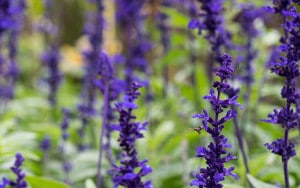Edging plants are the unsung heroes of the garden and can be used for many purposes; to hide an untidy border edge, untidy leaves of taller plants, define a walkway, or even placed around the base of containers.
Choosing evergreen plants means there will be year-round interest.
Scented leaved plants that are also evergreen provide year-round interest, as well as acting as a mood enhancer when scent is released. The fragrances can either be released by brushing past the foliage, or from the smell of the aromatic oils released by the plant on a sunny day.
Lavender
Lavender is a great example of this type of edging plant. There are many different flower colours to choose from, ranging from white to the deepest dark purple.
However, not all lavender varieties have neat compact growth habits, so be aware of this when choosing plants. For example, ‘Grosso’ produces beautiful deep purple flowers but its growth habit is long, which is perfect for a more informal area, but needs space, so perhaps not the most well-suited for edging a path. On the other hand, ‘Hidcote’ is perfect for path edging’
Lavender angustifolia (lavender) ‘Hidcote’
This is a much loved and popular variety of lavender with deep blue/lavender flower spikes. It also has a nicely domed shape, made up of scented silver-grey colour leaves. Their neat shape makes them an ideal choice to be planted close to the edge of a path. What’s more, its growing habit makes it perfect for a formal or highly manicured planting scheme as well as informal gardens.
- Flowers in summer
- Fully hardy
- Grows to 60cm tall
- Well-drained soil
- Full sun
- Sheltered

Bergenia (elephant’s ears) ‘Claire Maxine’
Another way of extending the interest of an evergreen edging plant is to choose one which flowers during one season and leaves change colour in another.
This is a great example, with magenta-pink flowers blooming on and off from spring onwards with shiny leaves that take on a red flush during the autumn months.
The common name comes from the fact that it has large, rounded leaves which are ideal for edging a path or border. It forms thick, ground covering weed suppressing clumps.
- Flowers in spring and summer
- Fully hardy
- Grows to 50cm tall
- Moist but well-drained soil
- Full sun or partial shade
- Exposed or sheltered

Hebe pinguifolia (hebe) ’Sutherlandii’
If you’re looking for a larger evergreen for edging in a sunny location, Hebes are a fantastic, low maintenance option. What’s more there are loads of different cultivars to choose from!
This variety is a pretty, mound forming plant, great for softening hard edged pathways. Not only that, but it would work well interplanted with Nepeta (catmint) ‘Kit Kat’. Being salt tolerant makes it the perfect choice for coastal gardens. It’s quick growing and once it’s reached maximum height and width, it becomes a very low maintenance plant. The long tapered white flower spikes bloom from late summer into autumn and sometimes as late as early winter.
- Flowers in summer
- Hardy in most places throughout the UK even in severe winters
- Grows to 60cm tall
- Moist but well-drained soil
- Full sun or partial shade
- Sheltered or exposed

Nepeta (catmint) ‘Kit Kat’
This is a low growing compact cultivar with pretty, light lavender colour flowers for weeks on end. It can retain its leaves in sheltered areas, but normally sheds them over winter. It’s ideal for creating a cottage garden atmosphere and, like lavender, works well planted front of border as it too because of the scented leaves.
- Flowers in summer and autumn
- Fully hardy
- Grows to 30cm tall
- Well-drained soil
- Full sun or partial shade
- Exposed or sheltered

Liriope muscari (lily turf) ‘Big Blue’
Liriope plants form elegant arching tufts with strap-like, arching mid-green leaves and have the added bonus of pretty bright-violet flowers late summer into autumn.
Evergreen and mound forming, it grows to a height and width of approximately 45cm. The violet flowers are followed by berries for added early winter interest.
- Flowers in summer and autumn
- Hardy in most places throughout the UK even in severe winters
- Grows to 45cm tall
- Moist but well-drained soil
- Full shade or partial shade
- Sheltered

Polystichum aculeatum (hard shield fern)
Evergreen ferns look fantastic growing in a shady border especially when used to encircle established trees. The hard shield fern is an evergreen native that develops a good shape and doesn’t grow too large. With an ultimate width and height of 50cm, it could combine well with the Liriope for a mixed edging scheme.
- Evergreen foliage
- Fully hardy
- Grows to 50 cm tall
- Well-drained soil
- Full shade or partial shade
- Exposed

Euonymus japonicus (spindle tree) ‘Green Spire’
Next is a very hardy, reliable, and neat looking evergreen that resembles box but without any of the pest and disease issues that plague them. It has small leaves that are a rich, deep green colour and is a very easy-to-grow plant. All that’s needed is to give it a light prune during the summer making it ideal for lining a formal pathway to tie in with other formal elements of the garden.
- Evergreen foliage
- Fully hardy
- Grows to 1m tall
- Moist but well-drained soil
- Full sun or partial shade
- Sheltered


Don’t forget Osmanthus Burkwoodii